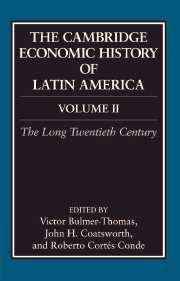Book contents
- Frontmatter
- Introduction
- Part I Cycles of Globalization
- Part II Onset of Modernization
- 5 The Institutional Framework
- 6 Fiscal and Monetary Regimes
- 7 Export-Led Industrialization
- 8 The Development of Infrastructure
- Part III Factor Endowments
- Part IV Sectoral Development and Equity
- Bibliographical Essays
- Index
- References
7 - Export-Led Industrialization
from Part II - Onset of Modernization
Published online by Cambridge University Press: 28 March 2008
- Frontmatter
- Introduction
- Part I Cycles of Globalization
- Part II Onset of Modernization
- 5 The Institutional Framework
- 6 Fiscal and Monetary Regimes
- 7 Export-Led Industrialization
- 8 The Development of Infrastructure
- Part III Factor Endowments
- Part IV Sectoral Development and Equity
- Bibliographical Essays
- Index
- References
Summary
INTRODUCTION
The title of this chapter requires, perhaps, some explanation. Accounts of trade and production in Latin America between 1870 and 1930 typically focus on the development of export economies; describe commodity cycles, their causes, and consequences; and attend, to a lesser degree, to the beginnings or acceleration of industrialization. Although I accept this scheme and, to an extent, follow it, the rationale for this chapter is different. For one thing, accounts of the commodity cycle are numerous, and the best ones can scarcely be bettered. For another, the emphasis on export economies, although by no means incorrect, is nevertheless somewhat misleading. Industrialization in Argentina, Brazil, Chile, Colombia, Mexico, and Peru was not independent of international trade, much less opposed to it, but complementary to, consistent with, or even consequent upon the expansion of the external sector. Even the advent of the railroad in Latin America, once understood primarily as a means of facilitating the production of exportable goods, is now known to have had a powerful impact on the domestic market in some places, such as Argentina, and was less associated with international trade in others, such as Mexico, than commonly supposed. Marco Palacios (the reader may consult the bibliographical essay for the literature mentioned in the text) has questioned the validity of the export-led model of growth in Colombia. Export-led growth did not begin in the 1870s but rather commenced in the twentieth century: only a small share of Colombian agricultural output – perhaps 10 percent – was exported. And although there were places, like Cuba, in which a conventional model in which a large part of infrastructure and industrial value added was the result of the spread of sugarcane, the welfare consequences of this development seem more debatable than they once were.
- Type
- Chapter
- Information
- The Cambridge Economic History of Latin America , pp. 249 - 292Publisher: Cambridge University PressPrint publication year: 2006
References
- 10
- Cited by



